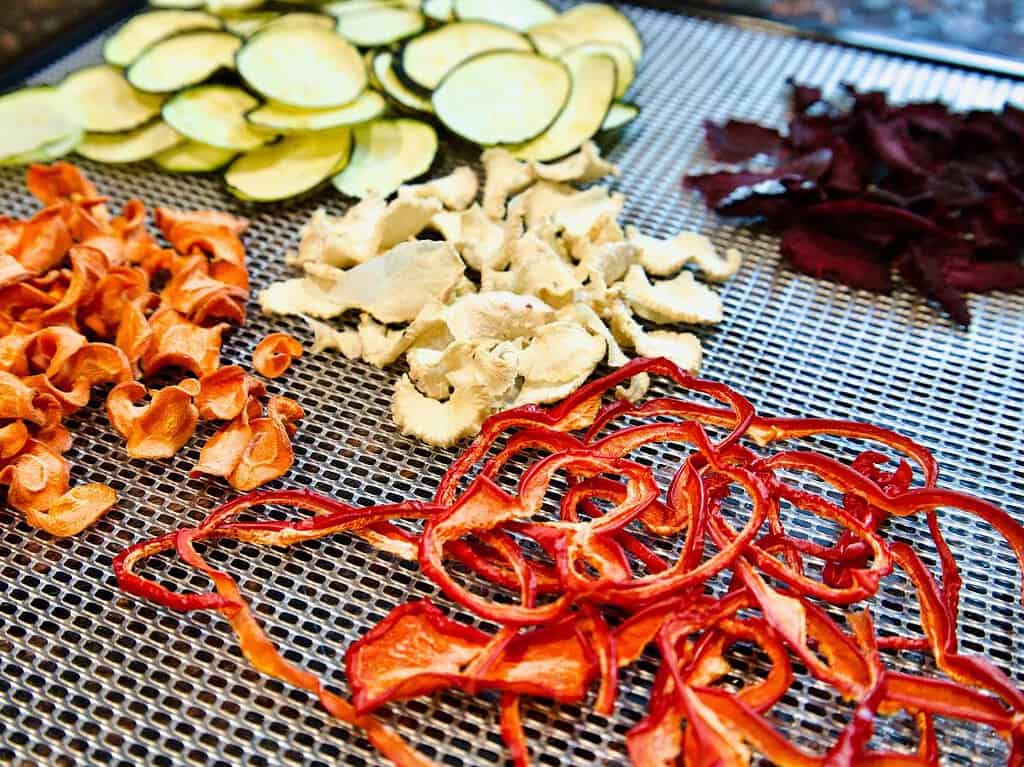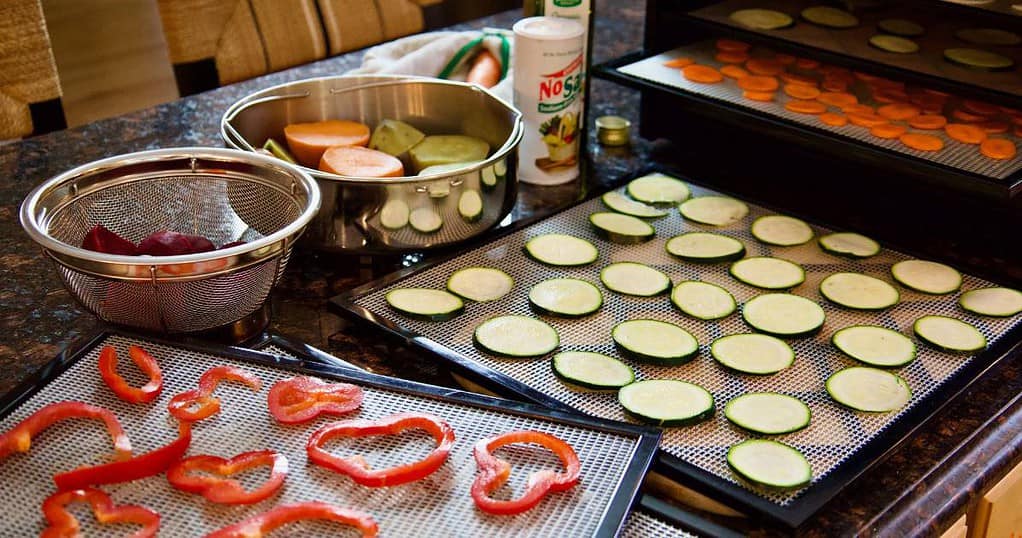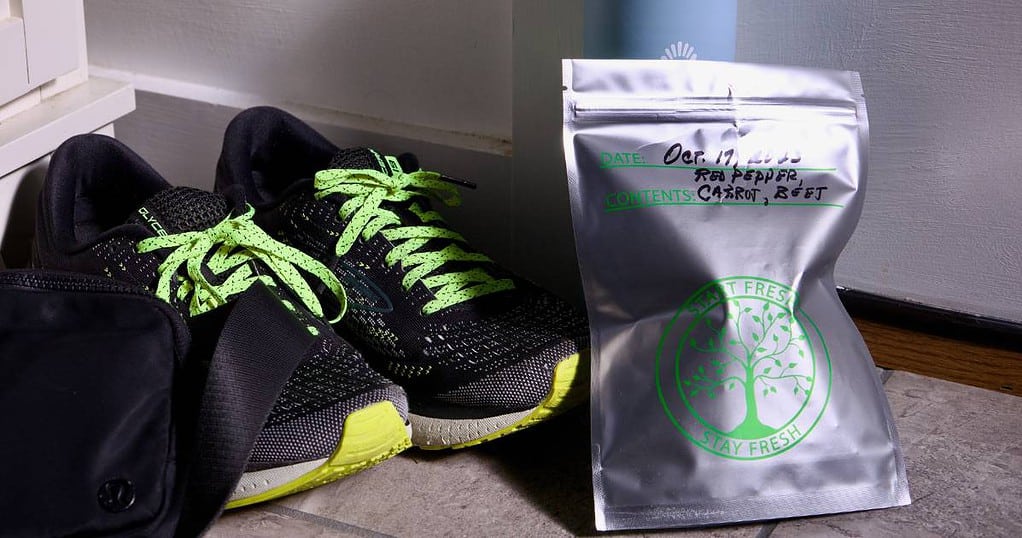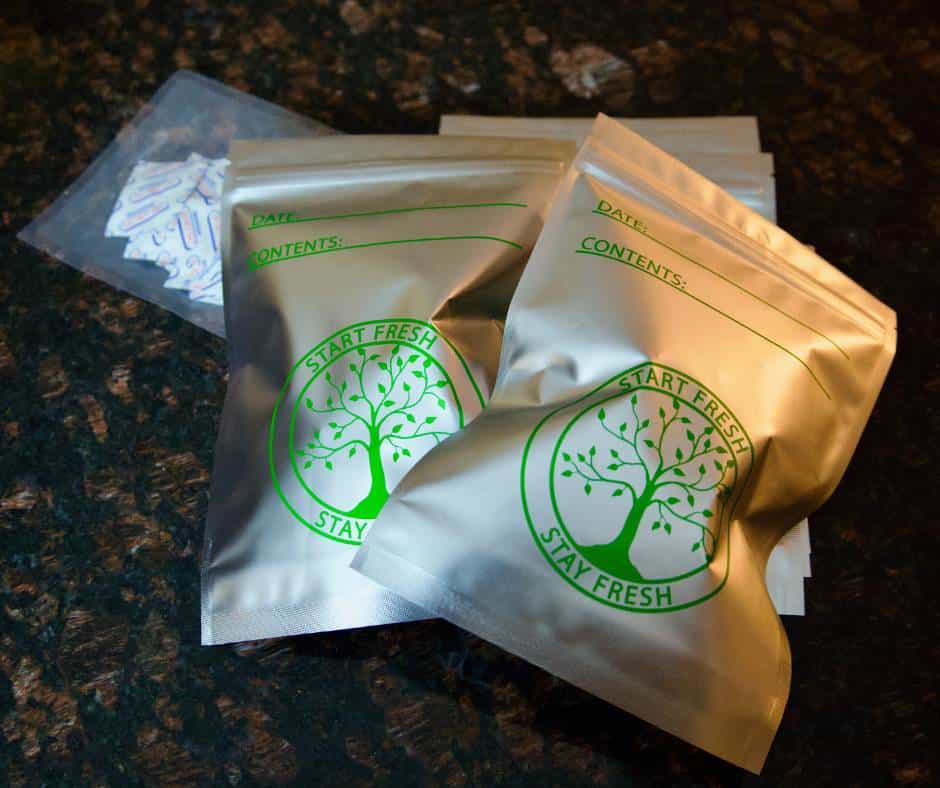Dried Food Tips: How Long Do Dehydrated Vegetables Last?
How long do dehydrated vegetables last? Much longer than fresh produce or even canned and frozen veggies. Discover food dehydration, a wonderful method of food preservation, and ensure your pantry is always stocked with delicious flavorful options for long term storage.

When I initially asked the question, how long do dehydrated vegetables last, I was thinking “Oh, about 6-12 months.”
After digging into the research, it turns out that with proper preparation, and if the food item is prepared and stored properly, dehydrated food can last a good long time. Like we are talking 10-15 years!
It is important to know the shelf life of dehydrated foods because not only does it ensure you are making the most out of your food investment but knowing the shelf life of food safeguards your health.
Having knowledge of the dehydration process and your long term storage needs is the best way to plan your pantry and meals more effectively, which will help reduce waste and save you money in the long run.
Using a food dehydrator is a great way to turn fresh vegetables into a crunchy healthy snack that holds its nutritional value. I enjoy using my dehydrator to make a variety of healthy snacks like kale chips, flax seed crackers, and dried cranberries to put on my delicious quinoa salad.
This article may contain affiliate links for your convenience. Also, as an Amazon Associate, I earn from qualifying purchases at no extra cost to you. You can read the full disclosure policy.

How Dehydration Works
The dehydration and drying process is based on a very simple premise, removing water and moisture content from fresh foods, which in essence preserves them.
This food preservation method has been around for centuries, and there are different food drying techniques, such as air drying, direct sunlight, or using special equipment such as an electric dehydrator where warm air continuously circulates gradually evaporating the water content.
Dehydrating food is a good option for long-term storage, and it leaves a lightweight, shelf-stable product with concentrated flavor and nutrients.
Vegetables, along with many other types of foods, are preserved through the dehydration process. When vegetables get dehydrated, water from the vegetables is eliminated.
This inhibits microbial growth from thriving, thereby preserving the vegetables, preventing spoilage, and creating a longer shelf life. The growth of bacteria, yeast, and mold is also inhibited when moisture levels are reduced from the food.
The Advantage Of Dehydrating
In comparison to other storage methods, there are some advantages to the dehydration method.

5 Factors Affecting Shelf Life
Here are 5 of the most important factors affecting the shelf life of dehydrated vegetables.
1. Temperature – the higher the storage temperature, the quicker the vegetables will degrade and you will lose nutrients such as potassium, magnesium, and vitamin C.
2. Humidity and Moisture Content – moisture is the true enemy of dehydrated vegetables. Even a small amount can cause spoilage so make sure you are storing your dried vegetables in a low humidity environment to prevent excess moisture.
3. Packaging and Storage Containers – proper packaging, such as vacuum seal bags, Mylar bags with oxygen absorbers, and airtight containers helps to keep moisture, air, and light away for a long shelf life.
4. Exposure to Light and Air – exposing dehydrated vegetables to light and air causes them to break down, leading to flavor loss and loss of nutritional value.
5. Quality of the Initial Product – food quality matters when it comes to long-term food storage. The quality of vegetables you purchase at the grocery store or farmer’s market makes a big difference in their shelf life, even after they’ve been dehydrated.

Determining The Shelf Life
When assessing the longevity of dehydrated vegetables, it is important to consider a few guidelines like moisture content, color, texture, odor, etc.
Dehydrated vegetables should have a moisture content of around 2-5% for optimal preservation. The lower the moisture content, the longer the shelf life.
Their color should be bright and vibrant with a crisp brittle texture. If the dehydrated vegetables look dull they may be deteriorating.
You can also do a smell test. Well-preserved dehydrated vegetables should have a mild, natural aroma. If they smell bad and rancid, chances are the dried vegetables are spoiled.
Also make sure to always inspect your dehydrated vegetables for any signs of mold, insect infestation, or other foreign matter.
Manufacturers are able to determine an expiration date for their dehydrated vegetables by sophisticated scientific testing and quality control processes.
Even so, it is a good idea to always do your own assessment on any dehydrated food whether it’s a commercial brand or dehydrated vegetables made at home.
How Long Do Dehydrated Vegetables Last?
In general, dehydrated vegetables can last anywhere from 6 months to 10, 15, years, or more. It all depends on how the vegetables are prepared and stored long-term.
Here are some examples of vegetables and their average shelf life if they are stored in an airtight container, and below room temperature – below 21° C/70° F.
Proper Storage Techniques
Aim to store dehydrated vegetables in a cool, dry place. The ideal temperature range is between 10°C/50°F and 16°C/60°F. Lower temperatures slow down the degradation process.
Humidity levels should be at 15% or lower to prevent moisture absorption by the vegetables. Make sure to use a proper airtight container or a vacuum sealed bag to help keep the humidity low within the packaging.
5 Storage Container Options
There are several ways to store your dehydrated vegetables, depending on your storage time, and whether you are looking for short-term or long-term storage options.
Vacuum-Sealed Bags
These bags are excellent for removing air and maintaining a low-humidity environment.
Pros: They come in a variety of sizes and are widely available. Vacuum sealing works very well for long-term storage.
Cons: You will need either a vacuum sealer machine, iron, or curling iron to seal the bag appropriately.
Mylar Bags and Oxygen Absorbers
The oxygen absorbers remove air from the bags and protect your dehydrated vegetables from light. If stored in a cool dark place, this option is also good for long-term storage.
Pros: These too come in a variety of sizes, are fairly inexpensive, and are widely available.
Cons: Not as good as the vacuum-sealed bags for maintaining a low-humidity environment but if you have a cool place to store your veggies, it is still a good option.

Glass Jars
Any kind of glass jar with a tight-fitting lid, like mason jars will work well for storage. You can also buy a kit that will vacuum seal mason jars, which can be handy.
Pros: Great for small to medium batches of dehydrated vegetables. Durable and easy to identify the contents in your container.
Cons: Not as good for large batches as the glass can get heavy. Also, best for medium-length storage, 3-6 months, versus long-term storage.
Food-Grade Plastic Containers
These containers with a snap-on or a screw-top lid are a practical choice.
Pros: Widely available, inexpensive
Cons: Only good for short to mid-term storage. Some people do not like to use plastic out of fear of chemicals leaching into their food. Personally, I prefer glass if I am going this route.
Zip-Top Plastic Bags
Not as effective as other options but okay for short-term storage.
Pros: Widely available, inexpensive, portable
Cons: Only good for short-term storage, and does not protect your dehydrated vegetables from moisture, air, or light as effectively as other options.
Extending The Shelf Life
There are a few things to keep in mind if you are looking for ways to extend the shelf life of your dehydrated vegetables even further,
Freezing your dehydrated vegetables in vacuum-sealed bags will extend your long-term shelf-life significantly. Especially if you are storing them in a low-temperature environment.
Using oxygen absorbers in vacuum-sealed containers or mylar bags helps to reduce the presence of oxygen, which can cause your dehydrated veggies to oxidize or spoil.
If you live in a humid environment, you may want to consider also using desiccant packs to help absorb any residual moisture in your storage containers.
Also, for added protection, you can always use double packaging. For example, using a mylar bag with an oxygen absorber, and then storing that mylar bag in an airtight container.
And finally, always store your dehydrated vegetables in a cool, dark area. Exposure to light will cause nutrient loss, and your veggies will degrade.

Cooking With Dehydrated Vegetables
The most popular way to consume dehydrated vegetables is by simply snacking on them. However, many dehydrating aficionados have learned other ways to use dehydrated vegetables.
Reconstituting dried food adds another dimension to the versatility of daily food preparation, and properly dried food rehydrates well, practically returning back to its original size and shape.
You can reconstitute your dehydrated vegetables by soaking them in water, placing them in boiling water, cooking, or using an electric steamer.
Dehydrated vegetables are incredibly versatile, and can be used in a wide variety of culinary dishes. Added to soups and stews, dehydrated veggies provide an abundance of flavor, nutrients, and texture.
Rehydrated vegetables are the perfect addition to rice and pasta dishes, enhancing the overall taste and making the meal more nutritious and delicious.
Dehydrated vegetables can be used in sauces, gravies, and salads, and they can be ground into a powder to create your own custom seasoning blends.
You can even add some finely ground dehydrated veggies to your baked goods to get that extra nutrient boost without it being overpowering. This is a great way to incorporate more veggies into children’s diets.
I tend to eat all of my dehydrated vegetables snacking around the house, and I really never have much left over to store!
When I am making dried food, I use my dehydrator machine, which makes it very easy. Just wash, slice, season, line the pieces in a single layer on a dryer sheet, and let the dehydrator do all of the work!
VIDEO: How Long Do Dehydrated Vegetables Last? Watch How I Use My Dehydrator
Safety Precautions To Consider
When working with food, there always are some precautions to consider, and that goes for dehydrated vegetables as well.
Moisture and Mold – moisture is the enemy when it comes to dehydrated food. If not stored properly your dehydrated vegetables could absorb moisture and begin to grow mold and bacteria. So it is important to make sure you are storing your food in a low-humidity environment.
Cross-Contamination – make sure your dehydrated vegetables are prepared and stored separately from raw meats to avoid cross-contamination.
Pathogen Risk – always wash, clean, and dry your veggies before dehydration. Even though water is greatly reduced through the dehydration process, it does not guarantee the complete elimination of harmful microorganisms. Just like with fresh fruits and veggies, you want to make sure to wash them thoroughly before using.
Quality of Vegetables – as with consuming fresh fruits and vegetables, the quality of your produce is extremely important, so make sure to buy fresh, preferably organic, produce without any bruises or soft and mushy areas.
The Shelf-Life Of Dehydrated Vegetables
How long do dehydrated vegetables last? Well, if prepared and stored properly they can last years!
It is important to buy fresh quality vegetables, prepare them for dehydration properly, and then store them in containers that will reduce oxygen and moisture and finally put them in a cool dark place for long-term storage.
Understanding the shelf life of dehydrated vegetables is also critical not just from a safety perspective but to help with meal planning, reducing food waste, and making sure we always have the most nutrient-dense, flavorful staple in our pantry.
I hope you embrace food dehydration and give this incredibly versatile food preservation method a try. With just a little bit of practice, you can open up a whole new culinary practice where the sky’s the limit!
FREE GUIDE: 5 Easy 100% Plant-Based Recipes For The Holidays
Check out these additional posts on dehydration and other delicious healthy recipes
Let’s Connect
If you enjoyed this article, I would love for you to share it with family and friends, or anyone you think might benefit from reading it.
Also, I would love to hear from you. Let me know in the comments below what kinds of produce you dehydrate, and what is your favorite dehydrated snack.

